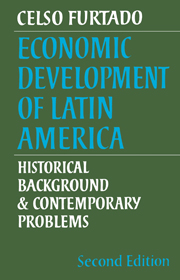Book contents
- Frontmatter
- Contents
- Tables
- Preface to the second edition
- Preface to the first edition
- Abbreviations
- Maps
- PART ONE FROM THE CONQUEST TO THE FORMATION OF NATION-STATES
- PART TWO ENTRY INTO THE SYSTEM OF INTERNATIONAL DIVISION OF LABOUR
- 4 The transformation of international trade in the second half of the nineteenth century and its impact on Latin America
- 5 Reorientation of the international economy in the present century
- 6 Some indicators of the degree of development reached in Latin America
- PART THREE THE TRADITIONAL STRUCTURAL PATTERN
- PART FOUR CHARACTERISTICS OF THE INDUSTRIALISATION PROCESS
- PART FIVE REORIENTATION OF DEVELOPMENT IN THE RECENT PERIOD
- PART SIX INTERNATIONAL RELATIONS
- PART SEVEN INTRA-REGIONAL RELATIONS
- PART EIGHT STRUCTURAL RECONSTRUCTION POLICIES
- Bibliography
- Index
6 - Some indicators of the degree of development reached in Latin America
Published online by Cambridge University Press: 25 January 2010
- Frontmatter
- Contents
- Tables
- Preface to the second edition
- Preface to the first edition
- Abbreviations
- Maps
- PART ONE FROM THE CONQUEST TO THE FORMATION OF NATION-STATES
- PART TWO ENTRY INTO THE SYSTEM OF INTERNATIONAL DIVISION OF LABOUR
- 4 The transformation of international trade in the second half of the nineteenth century and its impact on Latin America
- 5 Reorientation of the international economy in the present century
- 6 Some indicators of the degree of development reached in Latin America
- PART THREE THE TRADITIONAL STRUCTURAL PATTERN
- PART FOUR CHARACTERISTICS OF THE INDUSTRIALISATION PROCESS
- PART FIVE REORIENTATION OF DEVELOPMENT IN THE RECENT PERIOD
- PART SIX INTERNATIONAL RELATIONS
- PART SEVEN INTRA-REGIONAL RELATIONS
- PART EIGHT STRUCTURAL RECONSTRUCTION POLICIES
- Bibliography
- Index
Summary
Economic indicators
Whereas the period extending from the Wars of Independence to the 1870s was one of stagnation in nearly all the countries of the region, in the century that followed, the Latin American economies underwent relatively intense development, although the pattern varied from country to country. In the first half of the century - during which development was induced largely through the expansion of raw material exports-the regions with temperate climates and abundant empty lands received a large inflow of immigrants and capital from Europe. In these regions, economic development was particularly intense during this first phase and was accompanied by a precocious urbanisation process and other social changes. The essentially rural old society, in which political power was monopolised by a small minority of landowners, was rapidly transformed as large urban centres came into being, with the growing participation of the middle social strata. The southern region of the South American continent - Argentina, Uruguay and, to a lesser extent, Chile and the southern areas of Brazil - which had received an influx of European immigrants, became rapidly urbanised and the agricultural economy became entirely monetarised. An elastic food supply and the relatively high wage rates demanded by the European immigrants contributed to the establishment of much higher living standards than those prevailing in the areas settled much earlier.
Today, the living conditions of the Latin American population as a whole are basically an outcome of the social structures that emerged during their first phase of modern development – from about 1870 to 1914 – and of the intensity of this development from that period up to the present time.
- Type
- Chapter
- Information
- Economic Development of Latin AmericaHistorical Background and Contemporary Problems, pp. 58 - 67Publisher: Cambridge University PressPrint publication year: 1977



